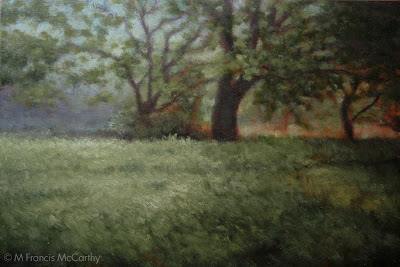It's too easy to drown out that quiet inner voice. Too easy to think we know what we're doing even if what we're doing is at cross purposes with our true intentions as artists.
I've written before about intuition here.
There is a reason that intuitive types are compelled by the arts. All art requires almost countless decisions to be made. The intellect alone finds this process tiring while our subconscious mind can do the same work automatically and effortlessly.
 |
| " Halfdome" by M Francis McCarthy |
Both aspects of our mind are required to do art. The intuition must have a direction and intention to work it's magic upon. And it is magical as it can solve mountains of problems in a single bound and get us to the answers we need.
 |
| My Studio at The Quarry Arts Center in Whangarei, New Zealand Also pictured is Denny the Poodle, My cohort at arms. |
"I'm convinced already! What can I do to tap into this intuition more?" you're saying.
Great question, you'll excuse me while I break out the bullets.
To access our intuitions more fully we can:
To access our intuitions more fully we can:
- Do that thing we just thought of doing. Don't put it off, act now.
- Take a stab with the brush loaded, at a spot on the painting that's bothering you. Then, deal with it...
- Don't lie to yourself when you see something wrong in your work. Intuition is always trying to point out those bad areas. BTW my personal tendency is to drown this voice out with lots of justifications.
- Pick up that book, find that bit of reference or ask that person to pose that you've been thinking about.
- Look for coincidence.
- Welcome the random into your work.
- Paint once, think twice.
- Use the biggest brush possible and turn that thing. Make it work.
You get the idea.
Cheers,
About today's illustration "Half-dome" this was done back in 2003 or so and was used as the basis for quite a few tee shirt designs. It was inked with a dip type pen and then scanned in and finished using a Wacom Tablet and Stylus. This Sucker is copyrighted by Jack Nightingale Artworks and reproduced here for portfolio, editorial and illustrative purposes only.
































